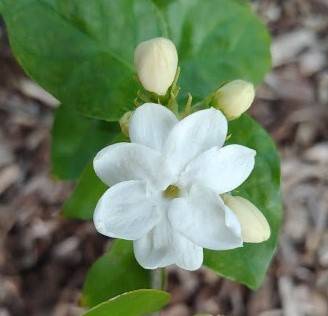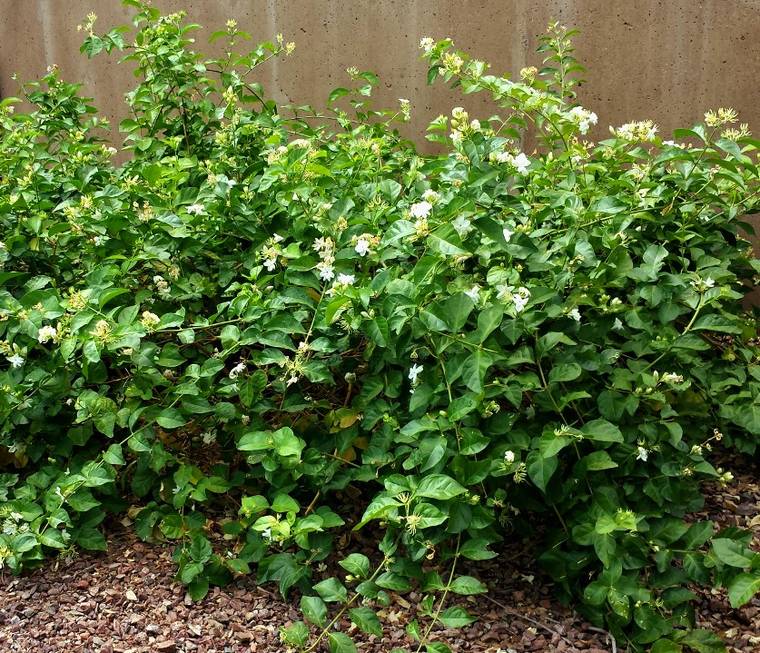The Arabian jasmine (Jasminum sambac) is known in Hawaii as pikake. This lovely plant produces a fragrant white lei flower and makes a wonderful addition to a Hawaiian garden. Though likely native to India and Southeast Asia rather than Arabia, its arrival in Hawaii so delighted Princess Ka’iulani that she named it after her beloved birds, the peacocks.
This jasmine is known by many different names throughout the world and is equally prized wherever it grows. It is the national flower of the Philippines and one of the three national flowers of Indonesia. Though in English it is a jasmine, it will always be called pikake here in the islands.
Jasmines are universally known for their sweet, heady fragrance and this species is no exception. Despite the universality of their strong perfume, not all jasmine relatives are the same. Here in Hawaii, it is important to know the difference.
The soft aroma that often wafts downhill on summer nights is that of the night blooming jasmine (Jasminum polyanthum). This invasive species that has overrun upland native forests may smell lovely, but should not be planted in our gardens. Several other jasmine varieties are nearly as invasive. Common or white Jasmine (Jasminum fluminense) and star jasmine (Jasminum multiflorum) as well as the Chinese jasmine (Trachelospermum jasminoides) sometimes known as confederate jasmine are all on the Hawaii invasive species list.
If you are looking for an attractive shrub that doesn’t threaten native forests but has flowers that fill the air with fragrance, consider pikake. Though it is in a genus called Jasminum it is a member of the Oleacea or Olive family. The family not only includes the olive tree but also claims several privet varieties as members. Most of the privets also have fragrant flowers.
‘Maid of Orleans’ is the Jasminum sambac cultivar that is most commonly grown here in Hawaii. This single flowered cultivar has pure white buds that are used in highly prized lei which are often worn in weddings or given as an expression of love. The pikake lei are so revered that many finely crafted plastic ones were made in mid-century. These vintage lei are still around and often given as gifts of love. Hapa’s Barry Flanagan even composed a lovely song praising the lei pikake.
Beyond lei making, the blooms of several of the J.sambac cultivars are used as an important ingredient in jasmine tea. The plants are also grown commercially for making perfume. From the pikake planted in your garden or potted on your lanai or in your home you’ll be able to use the flowers to flavor your tea or perfume your home.
PIkake plants produce flower clusters of three or more one-inch blooms most of the year. They open fully in early evening and may stay open for nearly twenty four hours but sometimes close by morning. Though they stay fragrant throughout the day, their perfume is actually strongest in the morning between 7 and 10 a.m.
The bright white flowers of the pikake make a striking contrast to the dark green leaves of the plant. It is an attractive plant to use as a single garden specimen or to include in a hedge. Because it is somewhat shade tolerant, pikake can also serve as a potted house plant. The plants have a shrub-like growth habit with long, woody, somewhat vining stems. Without support, plants will grow to two or three feet tall with long side shoots. These shoots can also grow quite high where they have adequate support and encouragement.
Since pikake plants rarely produce fruit in cultivation, propagation is usually done vegetatively, by layering or from cuttings. Though ground layering sometimes happens naturally with pikake, you can also encourage this propagation method. Anchor a side branch to the soil encouraging it to put out new roots at the point of contact. More detailed descriptions of this method can be found online by entering “horticultural layering.”
Taking a cutting about the thickness of a pencil and four to six inches long from a branch tip is another way to propagate pikake. Dip the cut end of the branch in a rooting hormone powder or liquid and place it an inch or more deep into a moist medium. Use a medium that holds some moisture but drains well. A half and half mix of vermiculite and perlite is a recommended medium.
Place the cutting’s container out of full sun and keep the medium moist but not wet. Monitor it regularly to be sure it remains alive and watch for new leaves. Once you see new leaves you can put it in a container of soil or plant it in your garden and fertilize lightly. Choose a location that gets sun at least part of the day. Keep it watered (but not soggy wet) until it starts to take off. Once established, pikake can tolerate somewhat dry conditions.
Despite the delicate appearance of the pikake flower, the plants are hardy survivors and can tolerate a wide range of conditions. Though they grow best in soil with a slightly acid pH between 5.5 and 7, they’ll do okay in most soils that drain well. They’ can even survive hot, dry sunny locations near the ocean, if protected from salt spray. Their flower production will diminish when nighttime temperatures drop much below 70 degrees.
Other than occasional trimming of the long branches to control size and shape, pikakes require little maintenance. Optimum flower production is achieved by keeping the plant compact and about four feet tall. House plants need to be in hanging baskets or have room to spread it you don’t want to be constantly trimming. Be sure to maintain new growth when you prune as that is where the flowers will appear.
You can bolster your pikake’s vitality by amending the soil with compost and adding a balanced fertilizer several times a year, particularly after pruning. Though somewhat draught tolerant once established, regular watering and fertilizing can encourage new growth. Avoid overhead watering of pikake plants as the flowers often turn brown when they get wet.
Overwatering and too much fertilizer can produce an abundance of tender new shoots that can attract insects. Whiteflies, mealy bugs, thrips, aphids, scale and spider mites are all possible pests of pikake. Monitor your plants regularly and treat them with a soap and oil mix applied late in the day if you see insects on them.
Wherever you choose to plant pikake in your home or garden, the sweet smell of its jasmine flowers is sure to delight you.
Diana Duff is a plant adviser, educator and consultant living part time in Kailua-Kona
Gardening Events
Most of the planned gardening events for this month have been cancelled or postponed.
This includes farmer’s markets and university sponsored events and services.


